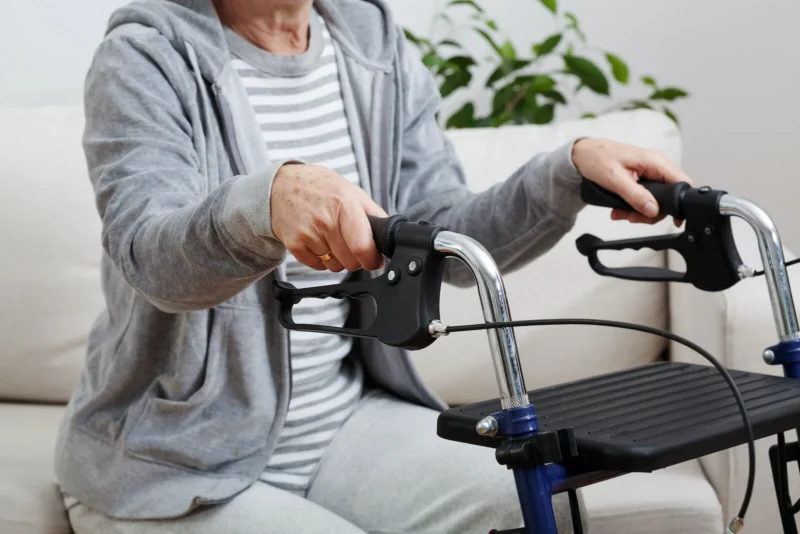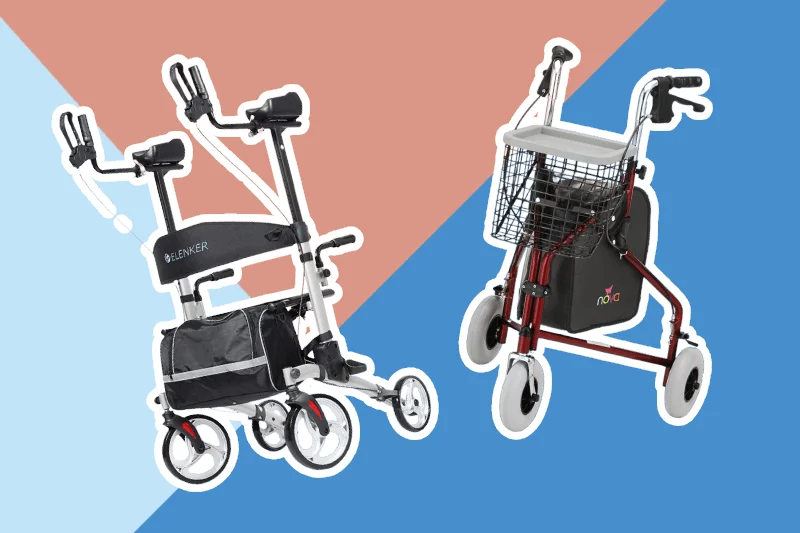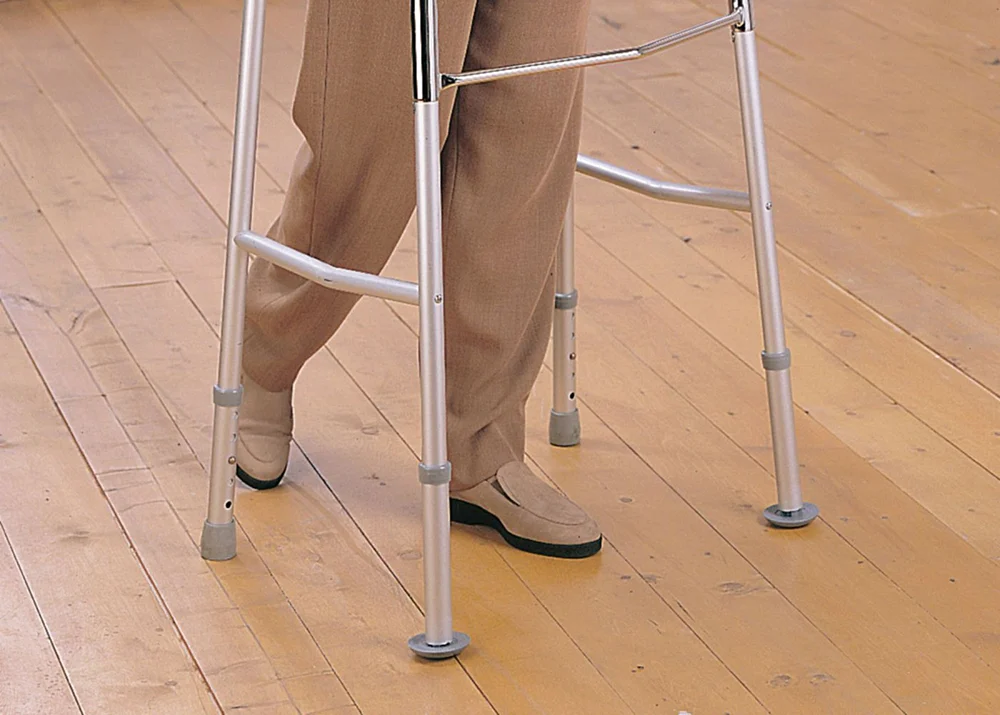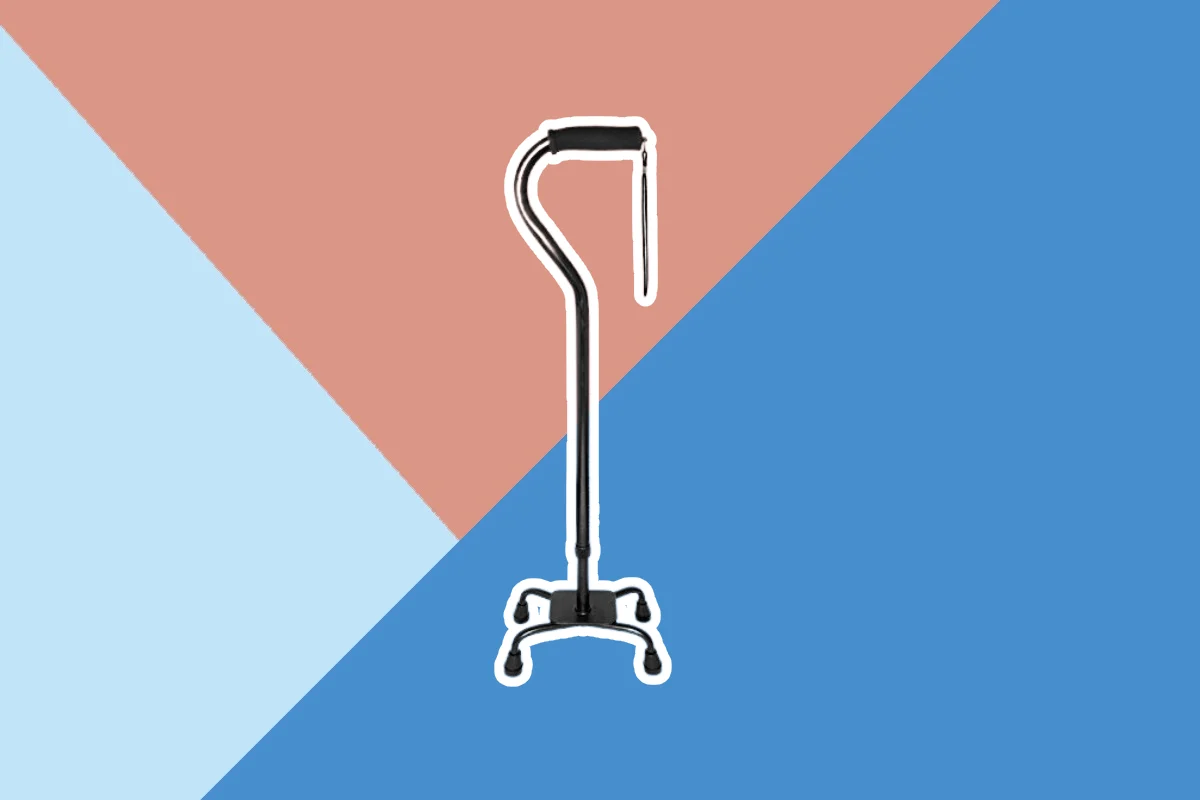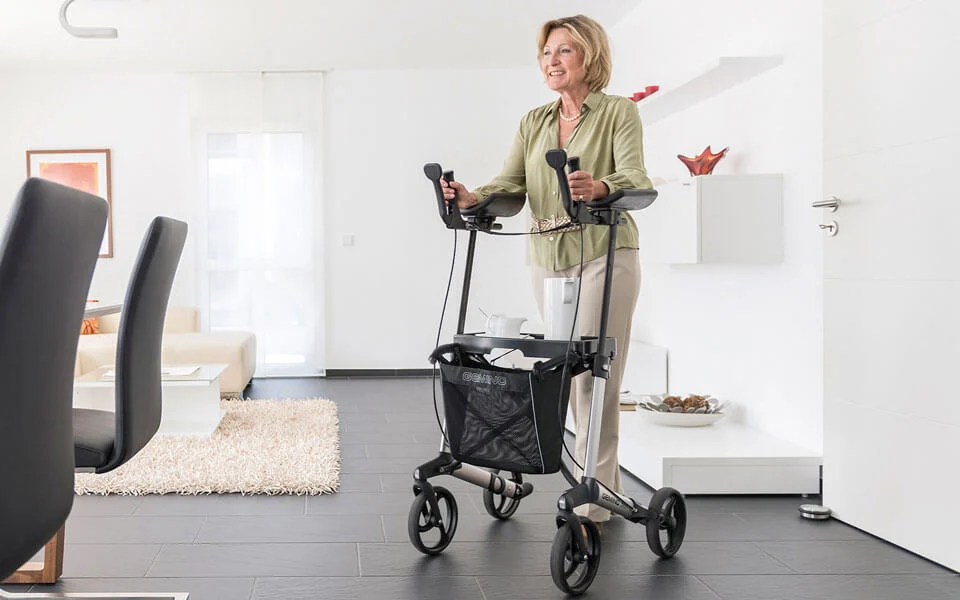Walker Brakes: Why They’re Essential for Safety
Are you shopping for a rollator with bicycle-style walker brakes? An efficient brake system is an absolute necessity for any walker with wheels. If the rollator does not stop immediately with a brief squeeze of the handle brakes, the senior or disabled person using it can easily be thrown off balance or collide with a person or obstacle. The grip must be ergonomic, or the senior could lose the walker altogether, having it roll down a hill or run into a car in a parking lot. If you buy a walker on wheels, it is a good idea to look for a model that has brakes that are similar to the ones on a tightened or loosened) to suit the user’s weaker or stronger grip, and the rear wheel brake pads should clamp the wheels tightly. Knowing how to loosen and tighten walker brakes is key to safety.
How Do Rollator Brakes Work? Understanding the Mechanism

The brakes on most rollators are called loop-lock brakes and they work in a similar way to a bicycle.
Walker brakes, which are technically known as rollator brakes or loop-lock brakes, are comparable to the kind of brakes multi-speed bicycle. They work by gently pulling up on loop levers that are located just beneath the grip handles of a walker. The grip is often rubber with indents for the fingers to grasp the senior’s hold on the rollator is secure. The brakes should have a lever located below the handgrips that can be adjusted.
On a quality walker, the lever on the brake is designed so that it is located quite close to the grip on the handle itself (much nearer than you would ever find on a bicycle brake.) Some styles of walkers stop simply by applying weight to the handlebars, but these are not considered as safe as the bicycle loop lock style hand of hand brakes as many seniors and disabled individuals leantoo heavily on the handlebars.
The lever on the rollator brakes is attached to a cable that is in turn attached to lever pads that compress the tires and immediately stop them from rolling forward. Try to find a rollator with a warranty, because even though you can buy a replacement hand brake with cable, a senior or disabled individual may not be able to fix it on their own, and sometimes it is best that the manufacturer provides the best repair.
Applying Rollator Brakes on a Walker
To apply the rollator brakes on a walker, you simply have to pull up on the levers that are gripped in your fingers. This tugs on a cable that causes brake pads to clamp down on the wheel. Keep in mind that the brakes on either side of the handlebar engage only the wheels on their respective side. So, if you pull up on the right-hand lever, it will stop the left wheel only and vice versa. If you want to pull to a full stop, it is important that hand brakes are applied simultaneously and with equal pressure. If one brake has pressure applied and not the other, then the walker will automatically make a tight turn.
How to Lock Brakes on a Rollator: Added Safety and Stability
To lock brakes in place, you apply pressure to the brake levers and press down, which will immobilize the wheels and put the walker in “park.” Some walker break styles will not lock in this way and have a metal loop that flips over the brake mechanism, in which case you may need to consult with the rollator brand’s manual for information.
For more detailed instruction on how to drive your rollator like a pro, check out this article about how to use a rolling walker properly, which goes into additional detail about how to lock it. So you can use it while standing and talking to someone, as well as how to adjust the handle height so that there is no strain on your arms or wrists and to make sure that you are not leaning too far forward. The American Association of Retired Persons (AARP) also provides a great deal of information about how to choose a cane or a walker Trusted Source How to Assess What You Need in a Cane or Walker One in four older adults may need a cane or walker, but choosing the right device is important for health and safety. Here’s how to get an assessment. www.aarp.org . In fact, for some people, using a walker is overkill when it comes to maintaining balance, it can throw them forward. Sometimes all a person needs to stay upright and steady is a cane; the rollator is not really the answer for someone who is limping so badly they throw their weight to one side.
How to Adjust Brakes on a Walker: Step-by-Step Guide
Adjusting rollator breaks is quite simple and tends to be the same process on most types and brands of walkers. These are general instructions about how to adjust the brakes on a walker.
- Examine the brakes until you find the adjustment screw located on the joint of the hand brake lever.
- Loosen the nut to allow you to either tighten the brake or loosen it.
Of course, specific instructions detailing how to fix walker brakes will be in your brand manual.
How to Tighten Brakes on a Walker: Ensure Optimal Performance

If you are unable to tighten your brakes enough by adjusting the brake handle screw, then you need to adjust a screw near the rear wheel of the walker.
- Examine the walker’s frame near the rear wheel to locate a brake adjustment screw.
- Loosen the brake adjust lock not to enable the screw to move
- Turn the screw counterclockwise to the desired brake tension.
Remember that it is absolutely crucial for the walker brakes to be at exactly the right tension, or accidents could happen. This study about four-wheeled walker injuries Trusted Source Four-wheeled walker related injuries in older adults in the Netherlands - PubMed This study presents evidence that older adults experiencing a fall while using a four-wheeled walker are at high risk to suffer severe injuries. pubmed.ncbi.nlm.nih.gov in older adults investigated the most common types of injuries caused by rollators and found that they were a major cause of hip fractures. As most walkers with wheels do not come out of a box fully assembled, make sure that the individual assembling the brake cable and attaching it to the walker itself makes sure it is safe and secure.
How to Loosen Brakes on a Walker for Better Maneuverability
Sometimes you can’t get the desired freedom of movement by adjusting the brake screws only. In this case, you need to locate the brake adjustment screw near the rear wheel and turn the loosened screw clockwise to loosen the brakes. If the individual using it still can’t manage the rollator properly because they have weak hands, lunge forwards, or can’t support their weight, buying one without wheels might be in order. This article about rollators versus walkers might help you investigate the differences between the two styles of walking assistance in more detail. In some cases, a walker without wheels might be safer and more stable, especially in situations where somebody needs to climb a lot of steps to accomplish their daily routine. Stabilizing yourself on four pegs might be more secure than trying to do it on wheels that are locked and unlocked by a hand brake.
How to Prevent Walker Brake Malfunctions: Regular Maintenance Tips
If you own a Walker or Rollator, you need to ensure the safety mechanism is functioning and for this, regular maintenance is key. It’s not hard to regularly inspect the general mechanism for wear and tear which could include fraying or rust on the cables, if the brake pads are worn down or damaged, or if the brake lever is cracking. Admittedly, all of these parts are generally pretty robust and so it is unlikely that you would have a failure on them.
The key inspection is the adjustment to make sure that the brakes are applying the right pressure with not too much to hinder free wheeling, and not too little to minimise stopping power. You should have a pretty good feel for this when operating the walker just by squeezing the handle to test it. By performing these simple inspections every now and then, you can ensure that your walker is doing its job correctly to get you safely and easily where you are wanting to go.
Choosing the Right Walker or Rollator For You
A rollator-style walker is a very personal item, so before buying, you must make sure it is going to be the perfect fit for the user. First, you should make sure that it can support the person’s height and weight and the width between the handlebar grips is wide enough to accommodate the person’s body. Obese and overweight individuals need wider handlebars, but many older, lighter individuals need rollators, as described in this article about the best narrow walkers for seniors. Also, the narrower the walker, the easier the walker will be to maneuver around the grocery store, public transit aisles, or even around the house. You might also want to consider that rollator with brakes may not be the answer for an individual with weak hands or one who needs to lean heavily on the handlebars, as using the walker brakes with some proficiency is crucial to its safe maneuverability and operation.
Bonus Tips for Protecting Hardwood Floors from Walker Wheel Damage
No one wants scratches on their hardwood floor due to their walker or rollator. Using the walkers and rollators on hardwood floors can sometimes lead to this due to either the wheels marking the floor. This can be due to either poor quality wheels marking the floor with bits of rubber, or if you are using your walker outside, picking up bits of dirt and sand which embed into the wheel before scratching the floor surface.
To prevent this damage, make sure that your walker is using non-marking wheels (which luckily most high quality ones do), and where possible use protective floor coverings. At entry ways, it is a good idea to use a soft mat to help clean any initial debris from the wheels from the outside. Protecting your floors not only preserves their appearance, but ensures that your ease of mobility doesn’t come at the cost of your homes aesthetics.
Adjusting, Tightening, and Maintaining Walker Brakes
We hope that you have learned something today which will keep you mobile when you want to, and stopping when you need to. Adjusting, tightening and ensuring your walker brakes operate smoothly is a pretty simple task, but one that is often neglected. Always be sure to check that you brakes aren’t hindering your movement forwards when off, and that they firmly operate to stop the wheels when they are on.
In addition, there are some small changes you can make like a mat at your front door to help prevent scratching of your hardwood floors to keep them looking great. By following these tips, you can ensure that your walker or rollator remains in a safe, functional and long-lasting condition to keep you moving with ease.










